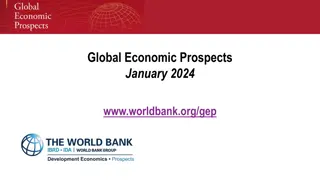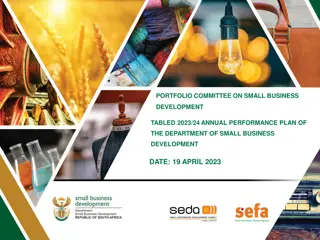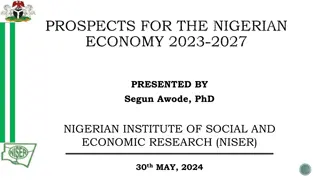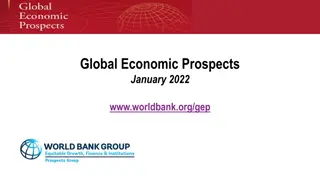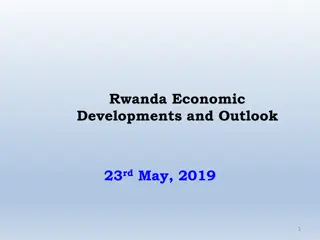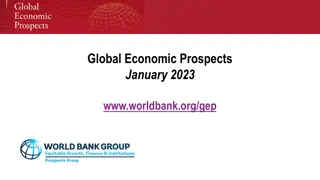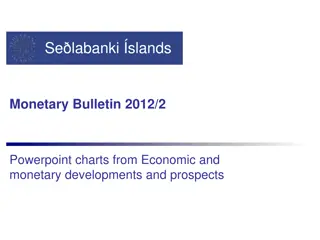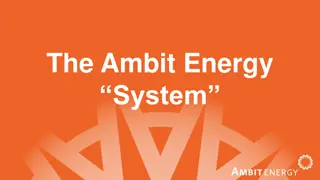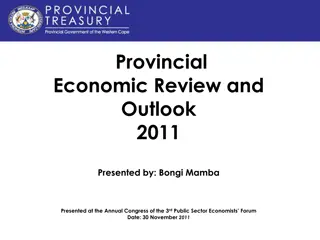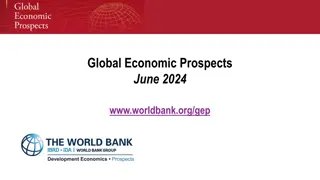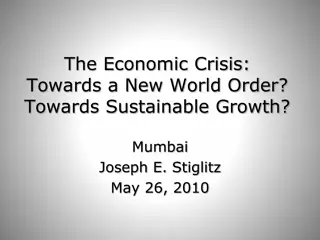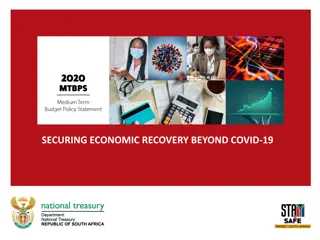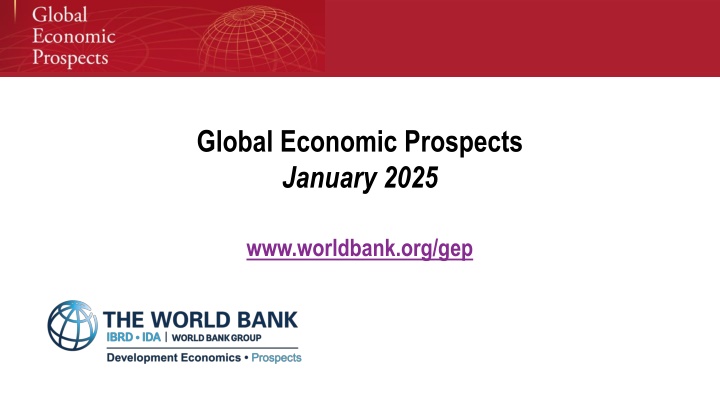
Global Economic Prospects January 2025 Overview
In the Global Economic Prospects January 2025 report by the World Bank, the global growth forecasts for the year highlight stability but a decrease compared to the previous decade. The report discusses various chapters focusing on the global outlook, regional perspectives, challenges for emerging and developing economies, and more. Additionally, it addresses risks to the global economy, including downside risks like adverse policy shifts and geopolitical tensions, alongside some potential upside risks. The report also delves into the role and impact of Emerging Market and Developing Economies (EMDEs) on the global economy, emphasizing their contributions to global growth and synchronization of business cycles.
Download Presentation

Please find below an Image/Link to download the presentation.
The content on the website is provided AS IS for your information and personal use only. It may not be sold, licensed, or shared on other websites without obtaining consent from the author. If you encounter any issues during the download, it is possible that the publisher has removed the file from their server.
You are allowed to download the files provided on this website for personal or commercial use, subject to the condition that they are used lawfully. All files are the property of their respective owners.
The content on the website is provided AS IS for your information and personal use only. It may not be sold, licensed, or shared on other websites without obtaining consent from the author.
E N D
Presentation Transcript
Global Economic Prospects January 2025 www.worldbank.org/gep
Global Economic Prospects January 2025 Global Outlook (Chapter 1) Regional Outlooks (Chapter 2) From Tailwinds to Headwinds: Emerging and Developing Economies in the Twenty- First Century (Chapter 3) Falling Graduation Prospects: Low-Income Countries in the Twenty-First Century (Chapter 4) 2
Global Economic Prospects January 2025 Underlying data and charts can be found at www.worldbank.org/gep A screenshot of a computer Description automatically generated 3
Global Growth Forecasts Stable, but Lower Than the 2010s Average GDP growth (Percent) Change from June 2024 2010-19 3.1 2.0 1.8 5.1 3.8 7.2 3.2 2.2 3.3 6.7 3.6 4.8 2023 2.7 1.7 0.9 4.2 3.5 5.1 3.4 2.3 1.7 6.6 2.9 3.6 2024e 2.7 1.7 0.9 4.1 3.5 4.9 3.2 2.2 1.8 6.0 3.2 4.1 2025f 2.7 1.7 1.4 4.1 3.8 4.6 2.5 2.5 3.4 6.2 4.1 4.6 2024 0.1 0.2 0.0 0.1 0.0 0.1 0.2 0.4 -1.0 -0.2 -0.3 -0.2 2025 0.0 0.0 -0.3 0.1 -0.2 0.4 -0.4 -0.2 -0.8 0.0 0.2 0.1 World Advanced economies Excluding the United States EMDEs Excluding China East Asia and Pacific Europe and Central Asia Latin America and the Caribbean Middle East and North Africa South Asia Sub-Saharan Africa IDA Source: World Bank. Note: IDA = IDA-eligible countries. Aggregate growth rates are calculated using GDP weights at average 2010-19 prices and market exchange rates; e and f refer to estimates and forecasts, respectively. http://www.worldbank.org/gep 4
Risks to the Global Outlook Multiple Downside Risks but Some Upside Risks Too Adverse policy shifts and heightened uncertainty Conflict and geopolitical tensions Trade fragmentation Persistently high interest rates Climate-related disasters Financial stress Stronger-than-expected growth in major economies Faster monetary easing with lower inflation 5
EMDEs: Global Role and Spillovers Greater Contribution to Global Growth; Larger Spillovers; Higher Synchronization Synchronization of business cycles (Index, 0-100 [most synchronized]) Share of global GDP growth (Percent) Impact of higher growth in EM3 and AE3 on EMDE output (Percent; one ppt increase in growth) 100 100 Within EMDEs 10 1971-2001 EMDEs with advanced economies 90 75 8 1993-2023 6 80 50 4 70 25 2 60 0 0 1990s 2000s 2010s 2020s EM3 50 -2 AEs EMDEs excl. EM3 1990s 2000s 2010s 2020s EM3 AE3 Source: World Bank. Note: AE3= United States, euro area, and Japan; EM3 = China, India, and Brazil; AEs= Advanced economies. Left Panel. GDP is measured in constant 2010-19 U.S. dollars. Bars for 2020s include data for 2020-24. Each bar showing the average contribution to year-on-year growth. Sample includes 154 EMDEs and 38 advanced economies. Center Panel. Cumulative impulse responses of growth in EMDEs excluding EM3 at a 3-year horizon to a 1 percentage point increase in EM3 and AE3 growth. Solid bars represent medians; error bars represent 16 84 percent confidence bands. Right Panel. Unweighted average of all the two-country concordance indices, based on quarterly real GDP, between two EMDEs or between an EMDE and an advanced economy over each decade. Data for the 2020s include 2020Q1-2023Q4. www.worldbank.org/gep 6
EMDEs: Growth and Poverty Weaker Growth; Slower Convergence and Poverty Reduction GDP growth (Percent) Average change in extreme poverty (Percentage points, annual average) Per capita income growth differentials (Percentage points; relative to AEs) 4 8 0.0 2000s 2010s 2020s 6 2 -0.6 4 0 -1.2 2 -2 EMDEs EMDEs excl. China and India EMDEs EMDEs excl. China 0 -1.8 -4 EMDEs EMDEs excl. China 1990s 2000s 2010-22 1990s 2000s 2010s 2020s Sources: UN World Population Prospects; World Bank; World Bank Poverty and Inequality Platform. Left Panel. Simple averages for each decade of annual GDP-weighted average growth in each group of economies. Data for the 2020s include 2020 24. Growth rates for 2024 are estimated. Center Panel. AEs = Advanced economies. Bars represent average annual GDP per capita growth in EMDEs minus the average GDP per capita growth in advanced economies, expressed in percentage points. Bars for 2020s include data for 2020-24.Right Panel. Average annual reduction in the share of people living in extreme poverty for each time period and group. www.worldbank.org/gep 7
Challenges Confronting EMDE Trade Growing Fragmentation and Uncertainty with Slowing Growth; More Restrictions Trade growth (Percent) EMDEs Advanced economies Trade-distorting policy measures (Thousands) EMDEs AEs Fragmentation and policy uncertainty (Index) 10 12 80 2 80 9 60 8 1 40 6 40 6 3 20 0 0 4 0 0 2022-24 2017-19 2017-19 2022-24 2 -1 -40 2000s 2010s 2020s 2000s 2010s 2020s Fragmentation Trade policy uncertainty (RHS) 0 Contribution Exposure (RHS) 1990s 2000s 2010s 2020s Sources: Caldara et al. (2020); Fern ndez-Villaverde et al. (2024); Global Trade Alert; World Bank. Note: AEs = Advanced Economies. Left Panel. The geopolitical fragmentation index extracts a common factor across various indicators relating to trade and financial flows, restrictions, and global uncertainty. A higher value implies greater fragmentation. Last observation is 2022Q4. The global trade policy uncertainty index quantifies changes in trade policy uncertainty by measuring the frequency of related terms in major newspapers; higher values indicate increased uncertainty. Last observation is November 2024. Center Panel. Period averages of annual real trade growth. Trade is measured as the sum of exports and imports of goods and services, measured as average 2010-19 prices and market exchange rates. Data for the 2020s cover 2020-24. Right Panel. Implemented interventions by countries that discriminate against foreign interests. Contribution represents the number of measures implemented by each country group. Exposure represents the number of measures affecting each country group. Each measure can be implemented by and target multiple countries. Adjusted data (for reporting lags) as of December 19, 2024. www.worldbank.org/gep 8
LICs: Performance and Prospects Concentrated in SSA; Behind Others That Were LICs in 2000; Weaker Graduation Prospects Per capita GDP (Index, LTM GDP per capita 1999 = 100) LICs-turned-MICs LICs LIC graduation trajectories (Number of LICs set to graduate) Number of LICs (Number of countries) 300 25 80 By 2035 By 2050 EAP LAC SAR ECA MNA SSA 20 60 200 15 40 10 100 5 20 0 2000-09 2010-19 0 0 1999 2004 2009 2014 2019 2024 2000 2005 2010 2015 2020 2024 Growth rates Source: World Bank. Left Panel. EAP = East Asia and Pacific; ECA = Europe and Central Asia; LAC = Latin America and the Caribbean; MNA = Middle East and North Africa; SAR = South Asia; SSA = Sub-Saharan Africa. Center Panel. LICs = low-income countries; LTMs = LICs turned into middle-income countries. Lines represent population-weighted GDP per capita. Country groups are consistent over time. Right Panel. Graduation trajectories assume that the threshold for LIC status increases at the same pace as it has since 2000. 2000-09 and 2010-19 growth rates are average growth rates measured in terms of GNI in U.S. dollars computed by the Atlas method. www.worldbank.org/gep 9
Growth Accelerations in LICs Rapid Progress During Accelerations, Stagnation Otherwise; Lower Number of Accelerations Per capita GDP growth (Percent) Change in extreme poverty (Percentage points) Growth accelerations in today s LICs (Number) 8 8 0 6 6 -1 4 4 2 -2 2 0 During accelerations Outside accelerations During accelerations Outside accelerations -2 0 -3 LTMs LICs 1990 2001 2012 2023 LTMs LICs Sources: Gootjes et al. (2024); WDI (database); World Bank. Note: LICs = low-income countries; LTMs = LICs turned into middle-income countries. Growth accelerations are defined as spells of eight or more years during which per capita growth rates exceed a country-specific threshold that incorporates both the long-term average and volatility of per capita growth. Left Panel. Annual averages during and outside growth accelerations. Sample includes 19 LTM accelerations and seven LIC accelerations. Center Panel. Average annual changes in the ratio of extreme poor to the total population. Right Panel. The number of accelerations depicted beyond 2016 may be low as any new accelerationswill not yet be captured aminimum of eight years of growth data are required to identify the start of an acceleration. www.worldbank.org/gep 10
Multiple Challenges to LIC Graduation Debt Distress, Conflict, Climate Shocks, and Food Insecurity Prevalence of intense conflict (Percent of countries, 2000-22) 100 Extreme climate events (Number of events per million km ) LICs in debt distress (Percent of LICs) Acute food insecurity in LICs (Millions of people) 200 FCS Other countries 100 100 Droughts Storms Floods 80 75 75 150 60 50 50 100 40 20 25 25 50 0 2019 2024 0 0 0 Low risk High risk Moderate risk In debt distress LICs LTMs LICs LTMs 2019 2024 Sources: EM-DAT (database); Global Report on Food Crises (database); International Monetary Fund; Uppsala Conflict Data Program. Note: FCS = Fragile and conflict-affected situations; LICs = low-income countries; LTMs = LICs turned into middle income countries. Left Panel. Shares of countries by risk of debt distress, as of September 2024. Sample includes up to 23 LICs. Second from Left Panel. Intense conflict years defined as those with more than 50 battle-relate deaths per million people. Second from Right Panel. Total number of events per million square kilometers of country area between January 2000 and May 2024. Right Panel. Number of people in food crisis as classified by the Integrated Food Security Phase Classification Phase 3, that is, in acute food insecurity crisis or worse. www.worldbank.org/gep 11
EMDEs: Multiple Growth Opportunities Need for Reforms in Governance, Trade Facilitation, Fiscal Policy Investment climate and corruption control in EMDEs (Index, 0-12 [highest]) Goods trade cost (Percent) Government revenue and expenditure in EMDEs (Percent of GDP) 35 200 (Index, 0-6 [highest]) 9 3 35 1995 2022 28 150 28 6 2 21 21 100 14 14 3 1 7 7 50 0 0 0 0 2000s 2010s 2020s 2000s 2010s 2020s 2020s 2000s 2010s 2000s 2010s 2020s 0 Investment climate Sources: International Country Risk Guide; International Monetary Fund; World Bank. Left Panel. Bars show group medians. Data for the 2020s cover 2020-23. Investment climate assesses risks to investment beyond political, economic, and financial factors; higher scores reflect lower risks. Control of corruption evaluates corruption within the political system. It reflects both actual and potential corruption. Higher scores indicate lower corruption. Sample includes up to 102 EMDEs. Center Panel. Bilateral trade costs (as defined in the UNESCAP-World Bank Trade Cost Database) measure the costs of a good traded internationally in excess of the same good traded domestically and are expressed as ad valorem tariff equivalents. They are aggregated into individual-country measures using 2021 bilateral country exports shares from WITS. Aggregates are averages of individual-country measures. Bars show unweighted averages. Sample in 1995 includes 34 advanced economies and 62 EMDEs; sample in 2022 includes 28 advanced economies and 86 EMDEs. Right Panel. Unweighted averages. Bars for 2020s include data for 2020-24.Sample includes up to 153 EMDEs. www.worldbank.org/gep Corruption control (RHS) EMDEs Advanced economies Government revenue Government expenditure 12
LICs: Multiple Growth Opportunities Need for Reforms in Resource Management, Agriculture, and Labor Markets Cereal yield and fertilizer use in LICs (1 ton per hectare) Natural resource rents in LICs (Percent of exports) Working-age population (Percent of total population) LICs Other EMDEs Advanced economies (Kgs per hectare) 4 160 100 80 2000-23 EMDE average 80 3 120 70 60 2 80 40 60 1 40 20 0 0 0 50 Cereal yield Fertilizer (RHS) 2000 2010 2021 1990 2020 2050 2080 Sources: UN World Population Prospects (database); WDI (database); World Bank. Note: LICs = low-income countries. Left Panel. Simple unweighted year averages of total natural resources rents (the sum of oil rents, natural gas rents, coal rents, mineral rents, and forest rents) as a share of exports. Sample includes 25 LICs. Center Panel. Average cereal yield per hectare of harvested land, and average fertilizer consumption per hectare of arable land in 2022. Right Panel. Other EMDEs = EMDEs excluding LICs. Population-weighted averages. Working-age population is defined as people aged 15-64. Population projections are from the UN World Population Prospects database. Based on 36 advanced economies, 25 LICs, and 117 other EMDEs. www.worldbank.org/gep 13

